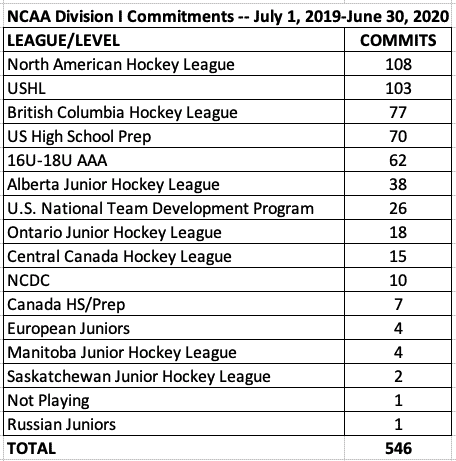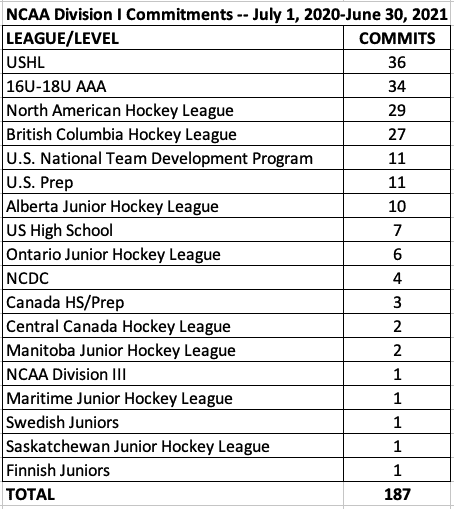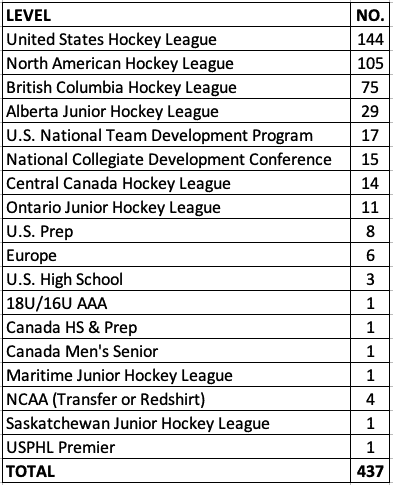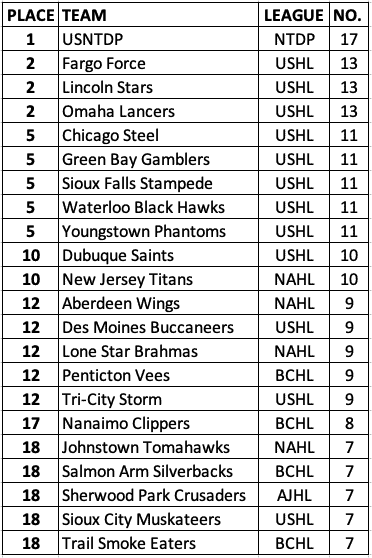We don’t’ pride ourselves in much at TJHP, but one thing we do really well is scrub for data regarding NCAA commitments and advancements. Obviously, the Pandemic caused some delays in the 2020 process because of lack of published rosters, lack of games being played, and all the other odd things that have taken place with our calendars (think Stanley Cup being hoisted in Summer before a long winter break of NHL hockey).
But we take what we can get in hopes of returning to normalcy soon.
The Most accurate NCAA Mens Hockey Commitment Data
First, our annual reminder of the difference in how we define “commitment” and “advancement.”
- Commitment: We only track at the Division I level as there are almost always legitimate verbal agreements being made between player and coaching staff. We track commitments and memorialize the data each month. We utilize data from College Hockey, Inc., and the longstanding Chris Heisenberg List, but both of these sources update the teams associated with the committed players as they advance through the ranks. By memorializing this data each month we have the most accurate data regarding WHERE the players are playing when the commitment is made.
- Advancement: We track this each year with NCAA freshmen at Division I and Division II/III levels. An advancement is from what team/level the player advanced DIRECTLY to his college roster.
It’s important to keep these straight before heading to your Twitter app and blasting us for having incorrect information. Our commitment data is the most accurate you’ll find anywhere due to our ongoing memorialization process.
EDITOR’S NOTE: There will be no NCAA Division III advancement data this year because of the complete lack of published rosters, NCAA Division III competition. That will pick up next year and we’ll publish in early December 2021. So you’ve got at least something to look forward to next year!
NCAA Division I Commitment data from 2019-20
Having gotten the housekeeping info out of the way we need to kick off the data presentation with the final NCAA Division I Commitment data from 2019-20.

Of note is the obvious fact the North American Hockey League (NAHL), a Tier II league within USA Hockey, squeaked past the United States Hockey League (USHAL), a Tier I league within USA Hockey in terms of sheer commitments. Yes – we know the per team capita is much higher in the USHL, but it’s still an impressive showing that has been gradually building for the NAHL, assisted somewhat by the fact the USHL limits the number of age-out players each team can roster (meaning some 20yos go from USHL to NAHL for the final year of Junior eligibility).
We also treat the U.S. National Team Development Program (NTDP) separately because (a) the NTDP does not own a USHL franchise and (b) it is operated unlike any Junior program in existence.
Also of note is the fact that U.S. High School (almost exclusively Minnesota high school players) and Prep Schools commit about the same number of 18U/16U AAA players. There is always a raging debate with parents, players, and even program operators about which path is better. This debate used to include Junior hockey as one of the options, but over the past decade, it has become a virtual certainty that your player will pass through at least one year of Junior hockey en route to college. The answer is specific to each player – we don’t advocate one way or the other because academics have to drive the bus – but more data is always better than less data.
2020-21 NCAA Hockey Commitment Data Thru Dec. 15, 2020
For 2020-21 we will be tracking U.S. High School and U.S. Prep separately, but even my North Dakota State mathematics skills will allow me to keep providing comparisons for this debate.
Since we’re on Commitments, let’s quick transition to the 2020-21 data through this week. Because of the fluid NCAA pandemic situation – with blanket waivers being applied to all players in all sports for 2020-21 – Junior rosters are being affected as many committed players returned to Juniors this year (e.g. there is little room and some view little reason to advance). There will be Junior teams that are 100 percent committed by the end of 2021.

Lastly, we have the 2020-21 NCAA Division I Advancement number for all 437 rostered freshmen.
Again, not a huge surprise other than the NAHL vs. the BCHL numbers which is always a raging debate with United States players. There is an old notion that the BCHL is a “better” place to play, which harkens back to a time when it was a better place to play. The NAHL over the past decade has obviously backed its marketing with performance. That is not a knock on the BCHL, it just means the two leagues are well respected by NCAA coaches who “strongly encourage” players to head to these leagues prior to matriculation.
You can also see that 12 United States players advanced directly from 18U/16U AAA, Prep, or High School compared with 414 from Junior leagues (94 percent of advancements. As an additional point of reference, last year’s NCAA Division III freshmen were comprised of 88 percent of players who matriculated from Junior hockey.

For additional, drill-down data here are the teams who advanced the most players from 2019-20 to NCAA Division I rosters.

Please use this data as you see fit when mapping out or discussing your hockey plan. I am always open to questions regarding this data and how it is put together. E-Mail me at info@juniorhockeyhub.com











